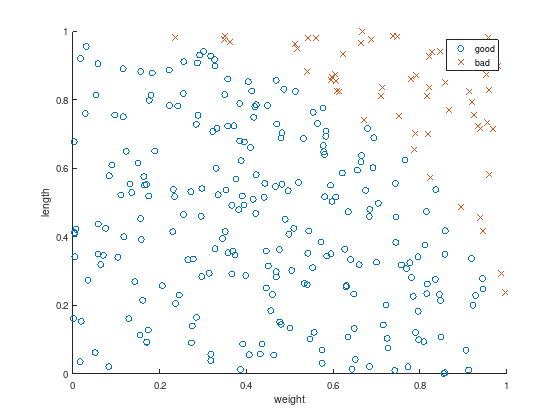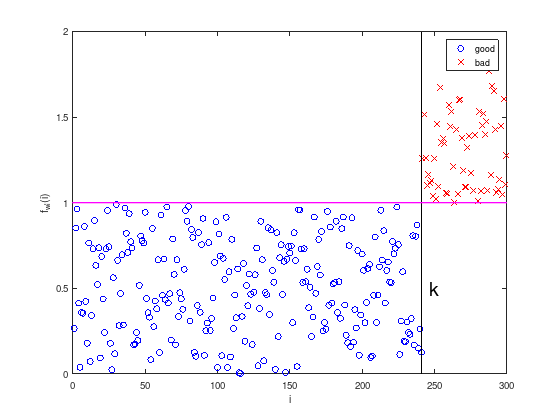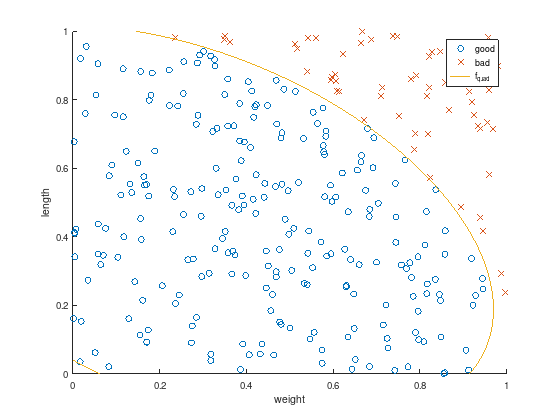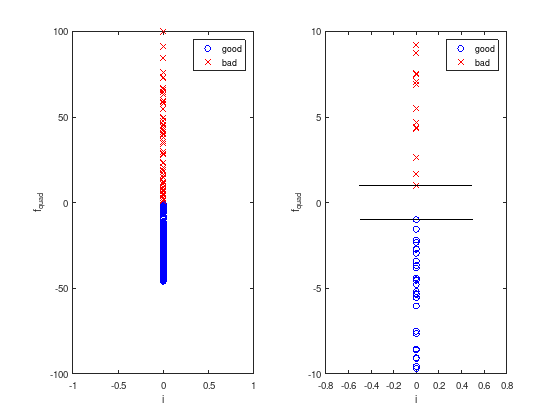LP03
Contents
LP03#
Non-linear classification#
See also exercise LP02 [BV04] (chapter 8.6).
Creation of labeled measurements (“training data”)#
Create \(m\) random data pairs \((w_i, l_i)\) of weights and lengths.
m = 300;
w = rand(m,1); % weight
l = rand(m,1); % length
Split the measurements into two sets according to a non-linear function (in this case an unit circle), such that a data pair \((w_i, l_i)\) is considered as “good” for \(1 \leq i \leq k \leq m\) and “bad” otherwise.
idx = sqrt (w .^ 2 + l.^2) < 1;
k = sum(idx);
w = [w(idx); w(~idx)];
l = [l(idx); l(~idx)];
Plot the resulting data to discriminate.
axis equal
scatter(w(1:k), l(1:k), 'o'); % good
hold on;
scatter(w(k+1:m), l(k+1:m), 'x'); % bad
xlabel('weight');
ylabel('length');
legend ({'good', 'bad'});

Classification#
It is obvious, that linear discrimination fails. There exists no linear function
to seperate
the “good” blue cicles: \(f_{\text{linear}}(w_i,l_i) \leq -1\) for \(1 \leq i \leq k \leq m\) and
the “bad” red crosses: \(f_{\text{linear}}(w_i,l_i) \geq 1\) for \(k < i \leq m\).
However, using a quadratic discrimination function will work in this example:
Roughly speaking, the quadratic discrimination function maps the data into higher dimensions (expanded measurement vector) and projects it to a scalar value. The optimization problem becomes finding a separating hyperplane in the expanded measurement vector, which is a linear classifier with the parameters \(x_0\) to \(x_5\). This technique has been used in extending neural network models for pattern recognition.
To illustrate the approach, consider the squared sum of the test data’s weights and lengths:
with \(1 \leq i \leq m\).
axis equal
plot (1:k, w(1:k) .^ 2 + l(1:k) .^ 2, 'bo'); % good
hold on;
plot (k+1:m, w(k+1:m) .^ 2 + l(k+1:m) .^ 2, 'rx'); % bad
plot ([k,k],[0,2], 'k', 'LineWidth', 1);
plot ([0,m],[1,1], 'm', 'LineWidth', 2);
text (k + 5, 0.5, 'k', 'FontSize', 20);
xlabel('i')
ylabel('f_{wl}(i)')
legend ({'good', 'bad'})

Regarding the construction of the data set above, it is no surprise that \(f_{wl}(i) = w_i^2 + l_i^2 = 1\) is a separating hyperplane.
Feasibility problem as Linear Program (LP)#
For now let’s pretend, that the structure of the measurements (test data) is not known, and a general quadratic classifier is sought.
Like in exercise LP02 this optimization problem can be formulated as LP on the expanded measurement vector:
c = [0 0 0 0 0 0];
A = [ ones(k, 1), w(1:k), l(1:k), 2.*w(1:k) .*l(1:k), w(1:k) .^2, l(1:k) .^2; ...
-ones(m-k,1), -w(k+1:m), -l(k+1:m), -2.*w(k+1:m).*l(k+1:m), -w(k+1:m).^2, -l(k+1:m).^2 ];
b = -ones(m,1);
Aeq = []; % No equality constraints
beq = [];
lb = -inf(6,1); % x0 to x5 are free variables
ub = inf(6,1);
CTYPE = repmat ('U', m, 1); % Octave: A(i,:)*x <= b(i)
x0 = []; % default start value
%[x,~,exitflag] = linprog(c,A,b,Aeq,beq,lb,ub,x0); % Matlab: exitflag=1 success
[x,~,exitflag] = glpk(c,A,b,lb,ub,CTYPE) % Octave: exitflag=0 success
x =
6.6295
-113.1690
-171.7719
57.0760
115.8150
162.4596
exitflag = 0
The computed solution differs from the unit circle, but nevertheless perfectly discriminates the test data and a quadratic classifier is found without prior knowledge of the test data structure.
axis equal
scatter(w(1:k), l(1:k), 'o'); % good
hold on;
scatter(w(k+1:m), l(k+1:m), 'x'); % bad
f_quad = @(w,l) 1.*x(1) + w.*x(2) + l.*x(3) + 2.*w.*l.*x(4) + w.^2.*x(5) + l.^2.*x(6);
ezplot (f_quad, [0,1,0,1]);
title ('');
xlabel('weight');
ylabel('length');
legend ({'good', 'bad', 'f_{quad}'});

The quadratic discrimination function \(f_{quad}(w,l)\) maps all data into higher dimensions and projects it to a scalar value to distinguish “good” and “bad” data pairs.
subplot (1, 2, 1)
plot (zeros(k,1), f_quad(w(1:k), l(1:k)), 'bo'); % good
hold on;
plot (zeros(m-k,1), f_quad(w(k+1:m), l(k+1:m)), 'rx'); % bad
xlabel('i')
ylabel('f_{quad}')
legend ({'good', 'bad'})
ylim ([-100 100]);
subplot (1, 2, 2)
plot (zeros(k,1), f_quad(w(1:k), l(1:k)), 'bo'); % good
hold on;
plot (zeros(m-k,1), f_quad(w(k+1:m), l(k+1:m)), 'rx'); % bad
plot ([-0.5, 0.5], [1, 1], 'k');
plot ([-0.5, 0.5], -[1, 1], 'k');
xlabel('i')
ylabel('f_{quad}')
legend ({'good', 'bad'})
ylim ([-10 10]);

After this “training” the discrimination function can be used to classify other data pairs as well.
